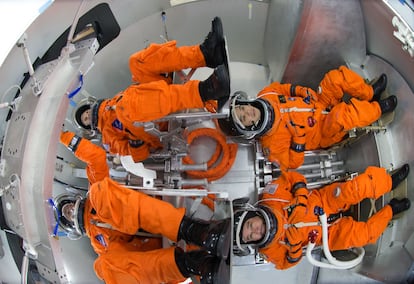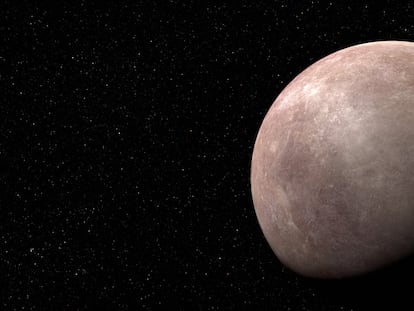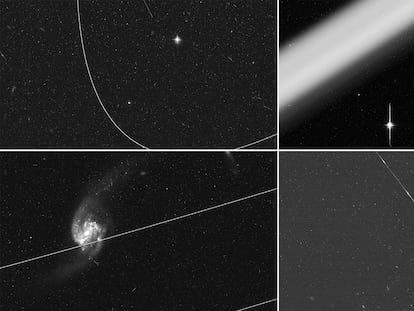NASA chief engineer Howard Hu: ‘We have built the best spacecraft that we’ve ever seen’
The man in charge of the new ship that will take astronauts to the Moon discusses the next manned missions to the Earth’s satellite and the possibility of people living there

Howard Hu was born in Shanghai, China, 53 years ago. When he was a little boy his family migrated to the United States, where his parents established themselves in the restaurant business, which meant that he would spend his early years alternating between being a dishwasher and a cook, all while reflecting that education could be his ticket to “a better life.” It was around that time that he saw Star Wars, which he calls “the catapult” of his career, because it was what made him realize that what he wanted most in the world was to build spacecraft.
That starry-eyed kid is now the head of NASA’s Orion program, the new ship that will be taking astronauts to the Moon and beyond. Hu studied aeronautics and astronautics in Seattle, joined NASA as an intern at age 22 and has not worked for anyone else since. He has actively participated in the agency’s most emblematic programs, such as the space shuttles and the International Space Station, the only inhabited place outside of Earth.
The engineer, who leads a team of approximately 3,500 people — both at NASA and at more than 800 supplier companies — was recently in Spain to meet with companies that took part in the construction of the European Service Module developed by the European Space Agency, which provides air, water, electricity, propulsion and temperature control to the Orion spacecraft. He showed them new data from Artemis 1, the first unmanned test mission, which returned to Earth after orbiting the Moon in December last year. In this interview, Hu outlines his upcoming goals, including making history by sending the first woman and the first person of color to the Moon by 2025.
Question. After Artemis 1, are you ready to send humans to the Moon?
Answer. We are going to test out the next version of Orion, called Artemis 2. That’s also a flight test. Artemis 2 will have crew; four astronauts. And so we’ll have new systems that will support the crew, for example, the oxygen delivery system and the flight control system. It’s very important that that integrated system, along with the ability to live on the spacecraft, is tested as well.
Q. What is it like to be inside the Orion?
A. I describe it as being inside a big SUV. Right as you enter the hatch, that’s where the toilet will be. And then you’ll see the seats, two above and two below, like bunk beds. And you’ll have the commander and the pilot, and they will see the displays and the switches. They’ll have the controllers and they’ll be able to navigate through the displays to get the information they need. When they get into orbit, the seats will be stowed and they’ll just float. It’s very cozy. They’ll have a little galley to prepare food; they’ll obviously have the toilet, which is like a very small telephone booth. [This is the first time that NASA includes something like this on a spacecraft to the Moon. 50 years ago, the Apollo astronauts, all men, urinated and defecated in bags, without privacy].
Q. How long will the astronauts be in the spacecraft?
A. After we launch out of Kennedy Space Center, the ship will orbit the Earth for 24 hours as we make sure that everything is good, that the equipment is ready to go. Then we’ll basically swing around the Moon and come back. This will be a 10 to 12 day mission, depending on when we launch. It’ll be a much shorter mission than Artemis 1, which took 25 and a half days. We’re targeting end of next year.
Q. And then there will be Artemis 3, in which a woman and a person of color will walk on the Moon for the first time in history. It will be very different from when the Apollo astronauts arrived. What exactly will we see during this mission?
A. The big difference is going to be the Starship lander [made by Elon Musk’s SpaceX], which is very big. For rendezvous and docking, with something that massive, we haven’t done something like that in lunar space. That’s going to be one of the big challenges. Of course, I think the videos are going to be much better than Apollo, not grainy and black and white. We’re going to really have a lot of good high definition video coming from the surface of the Moon. And of course, the suits are going to be different.

Q. Of all the places on the Moon, the cold and hostile south pole has been chosen for landing. Why?
A. Water. We think there could be concentrations of water on the dark side. We think we’ll be able to take ice cores and analyze them. We could also obtain oxygen and hydrogen from water, which would allow us to make fuel and oxygen to breathe in situ. If you don’t have to carry all your fuel and oxygen, and you have a refueling station for oxygen available, it would be a huge benefit long term. And there’s a lot of geological interest in the South Pole, because all the Apollo missions went to the lunar equator. The Orion is able to bring 100 kilos of rocks from the Moon. We’ll be able to analyze that and do some discoveries.
Q. How long will the astronauts be on the surface?
A. About six days. The first missions will be very short, establishing the science. As we go forward with Artemis 4 and beyond, we’ll begin to establish an infrastructure, long term habitats, logistic modules, rovers... all these things are needed. You need to have a long term capability to be able to live there for a longer time, days, weeks, months. That’s going to be very important.
Q. Will there be people living on the Moon permanently?
A. Potentially. We’re taking the early steps. When we get to Artemis 4 and 5 is when we’ll be able to deliver personnel to the Gateway, our lunar orbiting platform. The Europeans are providing several elements to the Gateway. And so the Orion will deliver the crew, and then there will be a lander, so they’ll get in the lander and go down to the surface, and then the crew will spend however much time they need there. Then they’ll get in the Orion and come home. It’s a taxi service. Think about it that way. Orion’s a taxi service to Gateway, and the lander is a taxi service down to the surface of the Moon. And in the meantime, other elements like rovers and habitats will be delivered down to the surface. There will be power generation capabilities and potentially a communications network. We will do all this together with our European, Japanese and Canadian partners, and companies from those and other countries. That’s what makes this such a powerful project.
Q. Critics of this program, including former president Donald Trump, say “we’ve been there before.” Why come back?
A. We always talk about the moon and beyond, right? What we want is to go to Mars, but we have to test the technology first. So what better opportunity than in your backyard, 100,000 miles away? At its closest, Mars is about 50 million kilometers from Earth. It takes us days to reach the Moon, instead of years. We need to test nuclear fission as fuel, habitable bases, exploration vehicles, resource exploitation. And we need more than just the infrastructure. We need the industry, the partners. We are going, and it’s truly the world that is going.
Q. Will the first manned missions to Mars be in the 2040s?
A. It’s hard to guess. Think about when the internet came, nobody predicted the transformation of, let’s say, e-commerce. It’s the same now. We’re really sowing the seeds, and we don’t know how fast they are going to grow. It could happen very quickly.
Q. Will Orion be the ship that takes us to Mars?
A. I would say Orion will be part of [the first expedition to Mars]. The spacecraft has the capacity to take four crew members for 21 days. Mars is further than 21 days; it could take up to two years. So we could be part of a broader mission. I certainly hope Orion will go beyond the Moon, but it will not be by itself.
Q. Artemis 2 includes manual controls for the astronauts, but will it generally run in automatic mode?
A. The spacecraft can launch and return the crew safely automatically. But in the Artemis 2 we will have some in-flight test objectives so that they understand the handling well, in case they need to take over for rendezvous or docking, for example. We’ll be doing a demonstration of that.
Q. As a child, did you dream of being an astronaut?
A. It may sound funny, but I dreamt of being an engineer. I saw the X-wing starfighters in Star Wars, and I was like, “wow, this is really neat. I want to build spacecraft.” And now I lead the development of the best spacecraft that we’ve ever seen.
Q. How far do you think humans can go in manned exploration?
A. I hope history will show that Orion and these missions were a stepping stone to something that allows us to go out of our solar system, to all those planets that we think may be habitable across the galaxy.
Sign up for our weekly newsletter to get more English-language news coverage from EL PAÍS USA Edition
Tu suscripción se está usando en otro dispositivo
¿Quieres añadir otro usuario a tu suscripción?
Si continúas leyendo en este dispositivo, no se podrá leer en el otro.
FlechaTu suscripción se está usando en otro dispositivo y solo puedes acceder a EL PAÍS desde un dispositivo a la vez.
Si quieres compartir tu cuenta, cambia tu suscripción a la modalidad Premium, así podrás añadir otro usuario. Cada uno accederá con su propia cuenta de email, lo que os permitirá personalizar vuestra experiencia en EL PAÍS.
¿Tienes una suscripción de empresa? Accede aquí para contratar más cuentas.
En el caso de no saber quién está usando tu cuenta, te recomendamos cambiar tu contraseña aquí.
Si decides continuar compartiendo tu cuenta, este mensaje se mostrará en tu dispositivo y en el de la otra persona que está usando tu cuenta de forma indefinida, afectando a tu experiencia de lectura. Puedes consultar aquí los términos y condiciones de la suscripción digital.
More information
Archived In
Últimas noticias
ICE raids trigger school absenteeism and traumatize children: ‘They have been forced to leave their childhood behind’
The guardians of the meteorites of the Argentine Chaco
Helen Levitt, the photographer who captured the theater of the everyday
The life of a delivery driver in China: ‘Many people don’t know how an order can arrive at their home in just one day’
Most viewed
- Christian Louboutin: ‘Young people don’t want to be like their parents. And if their parents wear sneakers, they’re going to look for something else’
- US sanctions against jailed cartel leader ‘El Marro’ highlight Mexico’s lack of control over its prisons
- The low-cost creative revolution: How technology is making art accessible to everyone
- Liset Menéndez de la Prida, neuroscientist: ‘It’s not normal to constantly seek pleasure; it’s important to be bored, to be calm’
- Cartels in Mexico take a leap forward with narco-drones: ‘It is criminal groups that are leading the innovation race’











































